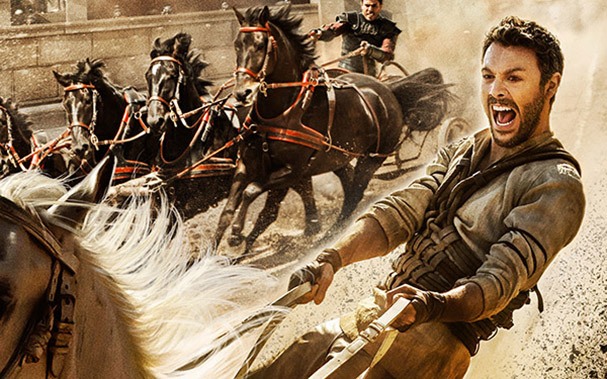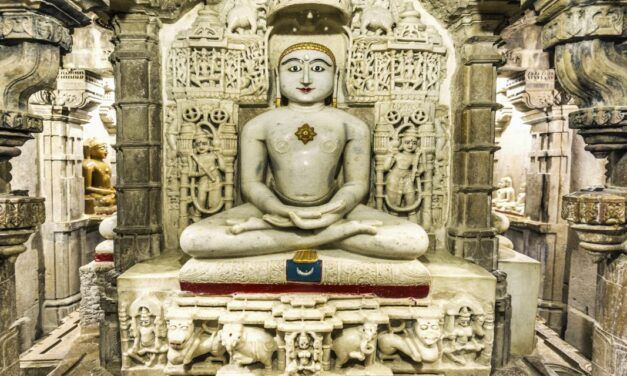A movie review of
Ben-Hur
Directed by Timur Bekmambetov
(Paramount Pictures and MGM, 2016)
The 1959 version of Ben-Hur starring Charlton Heston is Hollywood spectacle of the highest order. Its level of opulence perhaps can be measured best by its eleven Oscars, a record achievement matched only by two other enormous films, Titanic (1997) and The Lord of the Rings: The Return of the King (2003). This year’s remake of Ben-Hur is much smaller and leaner than its predecessor. It tries hard, but it just isn’t in the same league.
Thankfully the actors in the new version actually look Middle Eastern—several of them actually are—but they can’t hold their own against the legacy of Charlton Heston. Heston is not a “good” actor, but he is a larger-than-life presence who contributes to the epic grandeur of the original. The portrayal of Jesus, too, is less effective in the remake, even though they show more of him. Famously, the original film chose not to show Jesus’s face. Yet Jesus was still a powerful presence in that film. In particular, there is a moving scene in both films where Jesus offers the protagonist a drink of water in direct disobedience to a Roman soldier’s command. In the remake, Jesus is less confrontational and is portrayed as merely a quiet presence of compassion for suffering, downplaying his dangerous authority. In the original, he defiantly stands his ground and stares down the soldier who withers under the Son of God’s (off-screen) gaze.
Overall, the remake just seems smaller than the original, especially in the dialogue scenes, which are filmed mostly in close-ups. On the other hand, the new film is much more energetic—the camera is constantly moving—whereas the original was more staid and even lethargic at points. The action sequences in particular are much more urgent in this film. They are bloodier than the old film (earning a solid PG-13 rating) and are shot with shaky hand-held whip-pans and zooms. This works surprisingly well for the chariot race. (A seventy-year-old lady sitting next to me in the theater was literally on the edge of her seat with her eyes wide and her hand over her mouth.) But that technique doesn’t work as well in the slave galley, which is too frenetic to achieve genuine suspense. It is simply constant noise, without the slow building of rhythm and the moments of silence required to generate tension.
A Spiritual Journey. When it comes to plot and character development, the new Ben-Hur actually makes several genuine improvements over the classic version—at least until the last five minutes when the new film botches the most important element of the story. Ben-Hur is ostensibly the story of a first-century Judean prince’s conversion from revenge to forgiveness. The hero’s spiritual awakening never made perfect sense in the original, but here it makes even less sense.
In 1959, the character of Judah Ben-Hur started out as a devout Jew who chooses to support his own people even if that brings him into conflict with the Romans. He prays to God for strength at multiple points in the story as he struggles to hold on to his faith during years of imprisonment as a Roman galley slave. Judah’s most repeated prayer is that God will grant him revenge against Messala, the childhood friend who grew up to become the Roman military leader responsible for enslaving Judah and his family. Not all of Judah’s friends approve of his desire for revenge. Judah’s girlfriend Esther has become a Christian and tells him about Jesus’ teachings: “I’ve seen a young rabbi who says that forgiveness is better than hate.” Then, after escaping from slavery and defeating Messala in a chariot race, Judah happens to witness the crucifixion of Jesus, where a bystander tells him Jesus has “taken the sins of the world upon himself.” The movie ends with Judah returning home and reporting that he heard Jesus on the cross praying that God would forgive those who were crucifying him, “And I felt his voice take the sword out of my hand.”
This conversion seems rather abrupt, given that just the day before Judah confessed that getting revenge on Messala did not quench his “thirst.” He had said he still has unfinished “business with Rome” and was planning to join a zealot’s violent rebellion. Now merely seeing the “look of peace” in Jesus’ eyes and the graciousness with which he accepted his innocent suffering, Judah was instantly transformed into a pacifist. It doesn’t make a lot of sense as character development.
Seeing Both Sides. In fact, Messala’s betrayal of Judah at the beginning of the original Ben-Hur doesn’t make a lot of sense, either. But the remake succeeds in giving the characters intelligible motivations, at least for the majority of the film. It does this in large part by portraying the political context more clearly, emphasizing the role of the Jewish zealots in first-century politics. For example, it is clearer in the remake that Judah’s family is comprised of the sort of wealthy aristocrats who benefited from the Roman occupation and did not support the zealots’ political rebellions (somewhat like the Herodians mentioned in the New Testament). As one zealot accuses Judah, “You confuse peace with freedom.” Judah is a collaborator, willing to overlook the oppression of his people as long as his family is personally well off.
In the remake, the conflict between Judah and Messala arises when Judah begins to have sympathy for the zealots. Early in the film, Judah witnesses a zealot’s crucifixion and explicitly rejects the idea of resisting Rome. This might seem similar to Jesus’ teaching on nonviolence, but Judah also explicitly rejects Jesus’ call to love one’s enemies, saying instead that people have to take care of themselves. Unlike in the original film, Judah is portrayed here as a skeptic. He doubts there is a God, saying that God doesn’t do anything to help the poor and needy.
At first, Messala and Judah agree that they should fight for “civilization, progress, prosperity, and stability.” Messala regrets joining the Roman army and recognizes its oppressiveness. Judah says he doesn’t care about politics, only peace. Both agree in avoiding violence and are complacent about Rome. But then Judah hears the story of a zealot whose father was killed and whose mother was raped by the Romans. This seems like a genuine political awakening for Judah, who refuses to hand the zealot over to Messala, even after the zealot attempts to assassinate Pontius Pilate.
The remake tries hard to show that both Judah and Messala have good intentions. Messala is just trying to find a scapegoat that can placate the Romans and prevent the sort of mass death a Roman military invasion would bring, and Judah is trying to protect those he sees as misguided victims of Roman oppression. This makes for good drama and helps us sympathize with the characters better than we did in the original. Yet the remake never finds a plausible political solution to the real sources of division. The film changes Messala from Judah’s childhood friend to his adopted brother, a Roman. Their family hopes this relationship will “be an example of unity in this divided land.” Like the original film, it simply asserts that “loving” and forgiving your enemies will somehow be enough to produce peace and political unity. What this has to do with Jesus is never addressed in the film.
Speaking of Jesus, there is a scene in which He protects a leper from being stoned by shielding him with his own body. Jesus tells the crowd to love their neighbors as they love themselves and reiterates the film’s theme about unity as an alternative to the divisiveness of Roman ambition: “Hate, anger, fear—those are lies they use to turn you against each other.” Pilate witnesses this scene and declares that Jesus is “more dangerous than all the zealots combined,” though, again, it is not clear why he would think so.
There is something right about all this—Jesus really is a threat to oppressive political systems, and Christian love really is the only hope for social stability and familial harmony—but the film does not explore these themes deeply enough. By giving us a superficial appeal to “unity” as an alternative to political action, Ben-Hur seems to be denying the possibility of earthly justice and appealing to a kind of quietism and otherworldly spirituality. Judah himself explicitly expresses this sort of stoic detachment when he is in the slave galley. Watching other slaves get beaten, he whispers to himself, “Don’t care; just survive” and “You can’t beat them; all you can do is outlive them.” You might hope that this is meant to be an immature viewpoint of a pre-Christian character, but Judah never really grows beyond this, even after supposedly giving his life to Christ.
Placing Family over Faith. Thematically, the remake is about overcoming family conflict, rather than spiritual salvation or even political awakening. Toward this end, marriage is given a more prominent role in characters’ moral transformation. Messala’s ambition early in the film is motivated by his desire to be worthy of marrying Judah’s sister Tirzah, and later when Esther is trying to talk Judah out of pursuing revenge against Messala and he says he doesn’t have anything left in life besides his hatred, she replies, “You have me.” His love of his wife, not his faith in God, will be his salvation.
This is a Hollywood movie, not a Christian movie. The religious elements are significantly watered down in comparison even to the original film. Despite the fact that the motivation for Judah’s spiritual transformation is left mysterious in both films, the original film’s treatment of Judah’s sister and mother is much better. In both films, the two women miraculously are healed of leprosy at the moment of the Crucifixion. In the original film, this occurs just after their profession of faith. Tirzah says, having seen Jesus carrying “the pain of the world” on the cross, she is “not afraid anymore” of her impending death. Having confessed her faith in Christ, she is healed instantly. The connection between faith and salvation is clear. In the remake, however, the healing seems random. The characters have no conscious faith in Christ, and even wonder aloud about how they were healed.
Jesus’s main message in this film is to love your enemies. We see his arrest when he says, “Those who live by the sword will die by the sword,” and we see him on the cross praying, “Father forgive them.” When Judah sees Jesus fall on the road to Golgotha and tries to offer him a drink of water, he is stopped by a Roman soldier. Jesus tells Judah not to retaliate against the soldier, saying, “I give my life willingly.” This willingness to die an innocent death, along with his prayer of forgiveness from the cross, seems to be the main motivation for Judah’s conversion.
As I mentioned before, this conversion is similarly abrupt in the original film, too. The remake adds another abrupt conversion. Messala implausibly survives the chariot crash and vows vengeance on Judah until Judah says, “I can’t fight anymore. I can’t hate anymore. All I can do is carry you. Forgive me.” This is enough to reconcile the two brothers, and they literally ride off into the sunset together while Morgan Freeman (who else?) informs us that “forgiveness and understanding reunited the family.” It is hard to see what this has to do with Jesus or how this will help those still oppressed by Roman occupation. I believe Jesus is in fact the key to moral and social transformation, but Ben-Hur leaves this all very mysterious and seems more interested in family harmony than political revolution or even spiritual salvation.
John McAteer is associate professor at Ashford University where he serves as the chair of the liberal arts program. Before receiving his PhD in philosophy from the University of California at Riverside, he earned a BA in film from Biola University and an MA in philosophy of religion and ethics from Talbot School of Theology.









